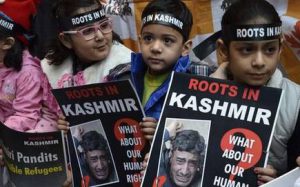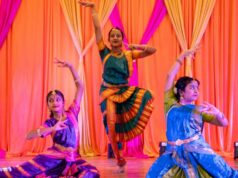I wonder if Medoff drew his inspiration from Kashmir when he chronicled the fascinating drama capturing the intensity of conflicting ideologies of speech and deafness and in the process creating tension and discord in their ever-developing romantic relationship.
James, ‘the adamant and energetic school teacher’ pitched against the ‘ever defiant yet independent’ deaf woman Sarah, persistent to crack the ice, encourage hesitant and defiant Sarah to set aside her insular life by learning to speak loud and shed the precedent.
The decades old polarity of opinions and ideologies, the immutability of opposing perceptions, the manifestations of the age-old dichotomy and the predictability of political chaos underpin the stalemate in the region of Jammu & Kashmir in many ways akin to the stage adaptation of “Children of a Lesser God”.
There is of-course another dimension to this juggernaut, that underpins the disparity and misinformation among the global community on what Kashmir really means. Who is a Kashmiri and what are his woes?
The word ‘Kashmir’ in modern times is a metaphor used to loosely refer to the geographic region in the wondrous Himalayas encompassing the regions of Jammu, Kashmir, Ladakh and Gilgit Baltistan. These are the territories which became part of the Princely Kingdom of Jammu and Kashmir during Dogra ruler Maharaja Gulab Singh’s military campaigns in 1840’s.
At one end of the spectrum the word Kashmir has been used as a synonym for the inhabitants of the Kashmir Valley (Hindus and Muslims) but at the other end of the spectrum is also colloquially used to refer to all inhabitants of Jammu and Kashmir from all the regions of the state.
This has often created a situation of disparity and identity entrapment for those who do-not identify themselves as ethnically Kashmiri, but are often labelled to have the same ideology, aspirations and opinions as an ethnic Kashmiri.
The recent decision to Bifurcate the state and to revoke the key clauses of Article 370 has suddenly opened up the debate for re-hashing the Kashmiri identity. It is no longer just the majority Sunni Muslim from the Valley of Kashmir or the Ethnically exterminated Kashmir Pandit who are at the centre of the narrative normally.
The focus is suddenly on the so-called Kashmiri’s, who do not normally identify themselves as Kashmiris – the ethnic Hindu and Muslim Dogra communities of Jammu, the Buddhists and Shias of Leh/Kargil, Gilgit Baltistan communities, Poonchies, Gujjars, Bakarwals – the children/Kashmiris of a lesser God, that have suddenly re-discovered their lost identity.

The recent changes in the legislation, almost God-sent have finally provided equal voice and space to all these diverse and often lesser known people of the region. These also include the forgotten Western Pakistani refugees from 1947, LGBT communities who have had none to very limited rights in the state. The changes ensure that the Women from the state even if they marry outside the state do not loose inheritance rights for themselves or their progeny and therefore overcomes the patriarchal bias in the previous clauses of Article 370 ( 35A).
Years have passed by and a generation of Kashmiris born in the conflict-ridden valley have lost all connect to the intricacies of a multicultural past of the valley. For those born and brought up in last 30 years, Kashmir valley has remained a zone in defiance with its own past and rich history.
Time has now also come for these Kashmiri’s to re-discover their roots and connect back with their rich and syncretic past. The infatuation with the century old cliché of a territorial logjam turned murkier by the Religious bigotry of its ilk is beginning to crumble. The perpetually deferred nostalgia of holding on to the status-quo and intertwined realms of real and rhetoric are sublimating into the new atmospheric ozone layer.
The long trapped destiny of Kashyap-Mira has recently been un-shackled. The future of the state can only be shinning bright from here on, but of course, it still needs to pass the last few hurdles of the black-hole it has simmered in for centuries. The uncharted distance between the wishes of the Majority Community and the aspirations of the Children of a Lesser God of the state, requires rehashing and re-defining the foundations of Kashmiriyat, Jamhuriyat and Insaniyat.
The coming together of two ends of the spectrum by recreating the diverse splash of rainbow colours of its past and allowing its people to immerse themselves in its chasm of the future opens up a vista of possibilities.
This new beginning has the potential to wash away the sins of its people’s Karma and the innate ability to chart a course that can flow in counter currents and thus allow the love, dignity and respect of its people to synergise and create a “Kashmir” of our dreams.

Vinod Tikoo
Vinod Tikoo is a Digital IT leader and a community activist based in London. A Kashmiri Hindu, born and brought up in Kashmir, Vinod represents the Jammu and Kashmir Study Centre, UK. The Centre is an advocacy and think tank on J&K. Vinod is also associated with the Kashmiri Pandits Cultural Society, UK; a leading voice of Kashmiri Pandits in the UK.

![Powerful Pride documentary Legendary Children [All Of Them Queer] streaming very soon](https://globalindianstories.org/wp-content/uploads/2025/06/Legendary-streaming-release-featured-238x178.jpg)



![Powerful Pride documentary Legendary Children [All Of Them Queer] streaming very soon](https://globalindianstories.org/wp-content/uploads/2025/06/Legendary-streaming-release-featured-100x75.jpg)

